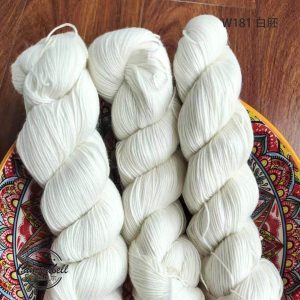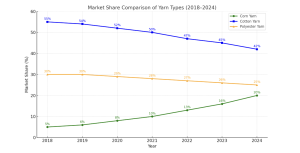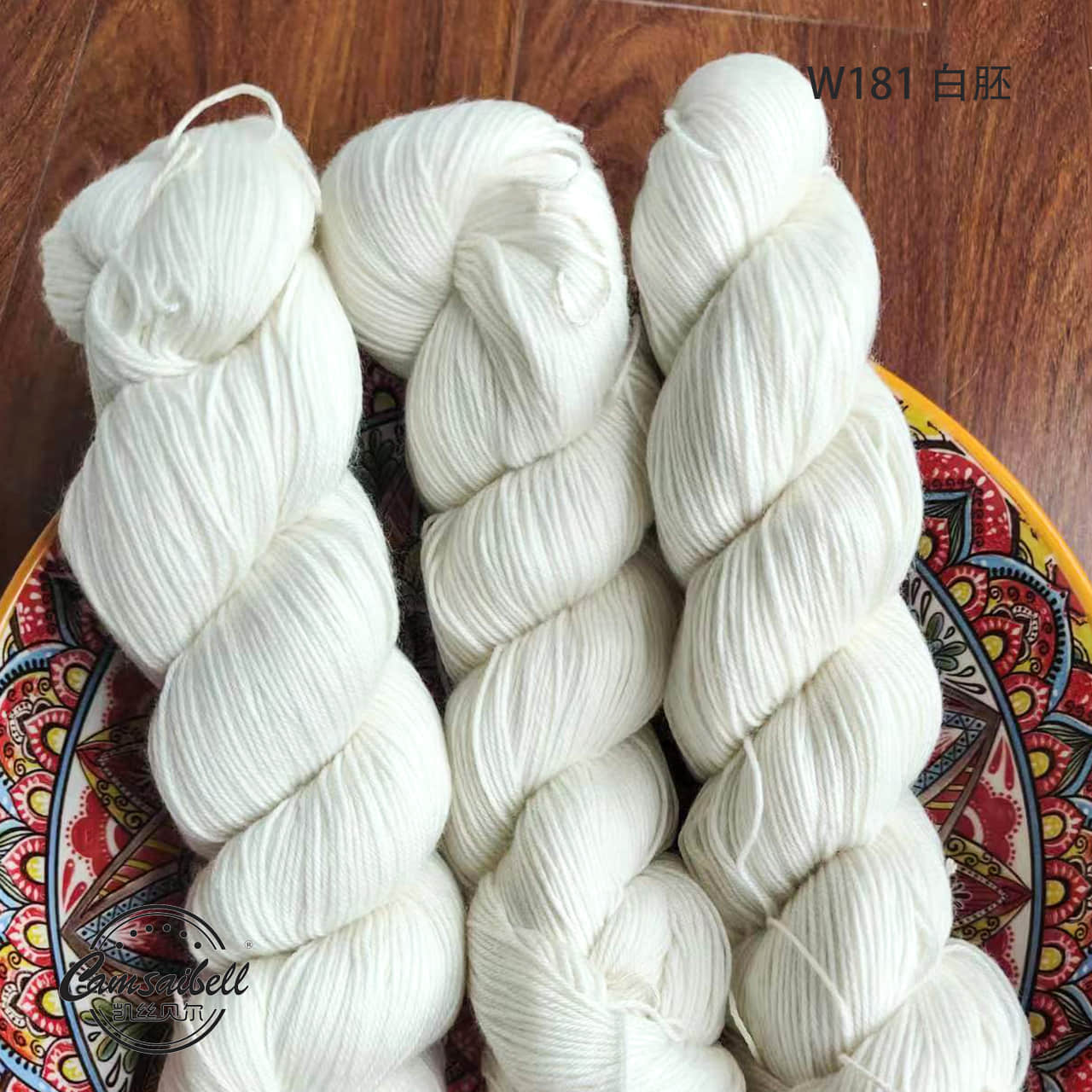This article provides a detailed introduction to corn yarn from the aspects of composition, functional uses and performance advantages. As an innovative yarn based on biomass, corn yarn has quickly become popular in the fields of clothing, home furnishings, maternal and child care, etc., especially in the context of increasing contemporary consumer concepts and environmental awareness, corn yarn has gradually replaced other yarns and become everyone’s ideal choice. If you have a need for corn yarn, you can come here to learn about it first.

What is corn yarn?
Maisgarn is a yarn made of polylactic acid (PLA) as the basic raw material, and PLA is mainly derived from corn starch or other crops rich in sugar (such as cassava and sugarcane). Through the processes of saccharification-fermentation-polymerization-spinning, this new synthetic fiber that is both natural and powerful is formed.
The essential characteristics of corn yarn are:
- It comes from renewable plant resources;
- It is 100% biodegradable and can be completely decomposed in an industrial composting environment in about 180 days;
- It can be recycled and reused, which conforms to the concept of “green circular economy”.
The main material of corn yarn
- Polylactic Acid (PLA): Bio-based polymer material, mainly derived from the fermentation product of corn or cassava sugar
- Carrier fiber (optional): Sometimes it is blended with organic cotton, viscose, and Tencel to improve performance
- Auxiliary ingredients: including stabilizers, antioxidants, anti-ultraviolet additives, etc. to enhance its durability
Its key features are non-toxic, non-polluting, and does not contain any petrochemical ingredients. It is a truly green and environmentally friendly textile yarn.

Main uses of corn yarn
Corn yarn is suitable for many occasions due to its comfortable touch and biodegradability:
- Clothing: T-shirts, sports bras, yoga clothes, baby clothes, socks, etc.
- Home textiles: bed sheets, towels, curtains, cushions, sofa covers
- Medical textiles: disposable masks, surgical gowns, gauze
- Non-woven fabrics/packaging materials: eco-friendly bags, biodegradable packaging bags, agricultural covering films
- Functional fabrics: antibacterial, moisture wicking, deodorizing functional fabrics
Main features of corn yarn
- Renewable raw materials: derived from plant resources, reducing dependence on oil;
- Degradable: can be completely decomposed into water and carbon dioxide in 180 days;
- Breathable and skin-friendly: light fiber structure with excellent breathability;
- Natural antibacterial: not easy to breed bacteria, suitable for infants and children and people with sensitive skin;
- Low carbon footprint: carbon emissions are 60% lower than polyester, more water-saving and environmentally friendly than cotton.

Summary of the advantages of corn yarn
| Advantage | Description |
| Environmental Safety | Biodegradable and compostable |
| Skin-friendly | Soft touch, hypoallergenic, excellent moisture management |
| Lightweight | Lower density than cotton or polyester |
| Anti-bacterial | Natural resistance to bacterial growth |
| Odor Control | Prevents sweat-related odor buildup |
| Eco Performance | Renewable source, lower energy & water usage in production |
Corn yarn vs. other yarn market share (2018–2024)
Market data shows that the share of corn yarn has increased from 5% to 20% in just six years, while traditional cotton yarn and polyester have gradually declined.

The above figure shows the trend of the global market share of three mainstream yarn types from 2018 to 2024:
- Corn Yarn: The market share increased from 5% in 2018 to 20% in 2024, reflecting that its environmental protection and bio-based characteristics are gaining more and more favor from consumers and brands.
- Cotton Yarn: Although it is still the main force in the market, its share has decreased year by year, from 55% to 42%, indicating that alternative materials are gradually penetrating.
- Polyester Yarn: It has declined slightly, but still maintains a stable market share, indicating that its cost and performance advantages are still attractive.
Comparative analysis of corn yarn and other yarns
| Feature | Corn Yarn | Cotton Yarn | Polyester Yarn |
| Source | Renewable (Plant-based) | Natural (Plant fiber) | Petrochemical-based |
| Biodegradability | ✔ Yes | ✔ Partial | ✘ No |
| Skin Friendliness | ✔ Excellent | ✔ Good | ✘ Moderate |
| Moisture Absorption | ✔ High | ✔ High | ✘ Low |
| Carbon Emission | Very Low | Medium | High |
| Durability | Moderate | Good | Excellent |
| Odor Resistance | ✔ Yes | ✘ No | ✘ No |
Schlussfolgerung: If you need to take into account environmental protection, comfort and biodegradability, corn yarn is the first choice.
How to buy high-quality corn yarn?
The purchase suggestions are as follows:
- Confirm the purity of the material: choose 100% PLA or blended yarn with PLA content;
- Check the certification: GOTS, OEKO-TEX, TÜV, USDA and other environmental certifications are recommended;
- Test performance parameters: such as breaking strength, linear density, moisture absorption rate, color fastness, etc.;
- Sensory evaluation: soft feel, natural color, no odor;
- Understand the use requirements: fine denier yarn is recommended for clothing; coarse yarn or non-woven fabric can be selected for packaging.
Recommended brands and suppliers
| Brand/Supplier | Country | Product Strengths |
| Jiangyin Loyal Yarns | China | Offer hand-dyed yarn. A variety of colors for you to choose |
| Suzhou PolyGreen | China | Focus on exporting bio-based fibers and biodegradable yarns |
| Shanghai TexLeader | China | Supplier of various PLA yarns, exporting to Europe, America and Japan |
| Unitika Eco Yarn | Japan | Leading in the research and development of antibacterial PLA yarn |
| ECONATEX GmbH | Germany | German high-end environmentally friendly fabric PLA yarn manufacturer |
If you need customization, wholesale or cooperation, please choose a manufacturer with third-party environmental certification and export qualifications.
Schlussfolgerung
Corn yarn is not only a reflection of technological progress, but also a representative of the development direction of ecological textiles. From its raw material source, biodegradability, market expansion speed to sustainable economic value, it is undoubtedly a promising new star in the future textile industry. As consumers pay more and more attention to green and environmentally friendly products, corn yarn is gradually moving from niche materials to large-scale commercial applications.





